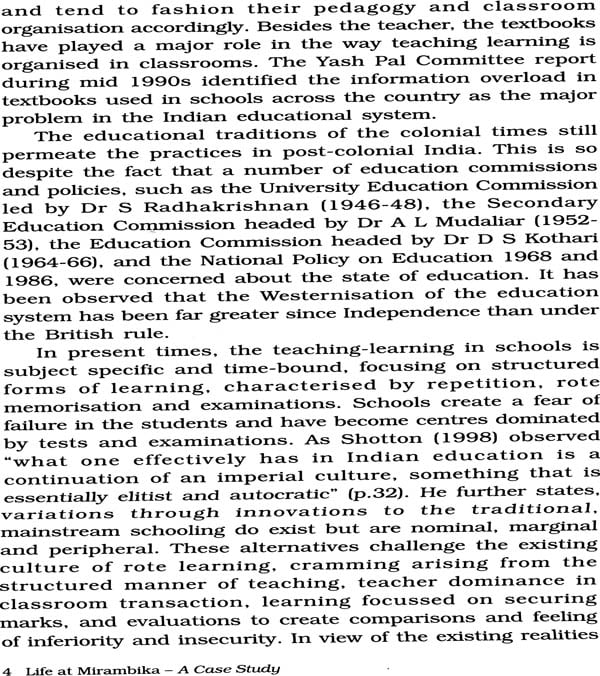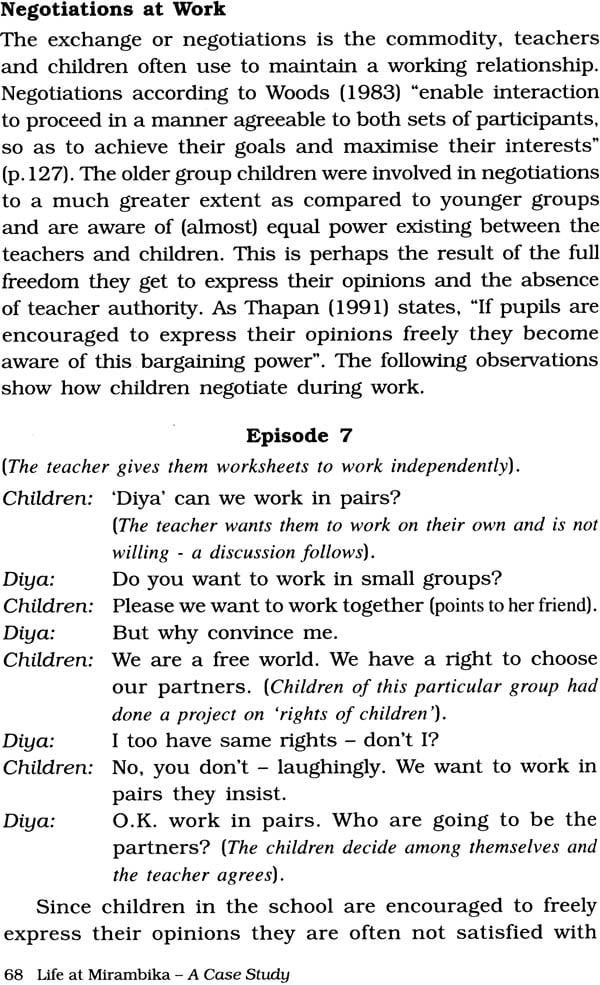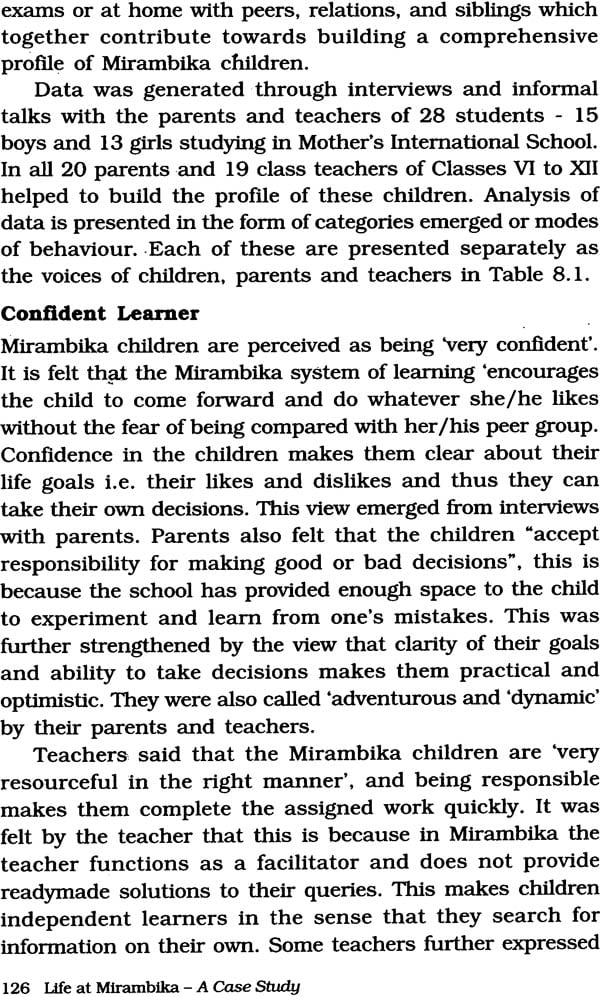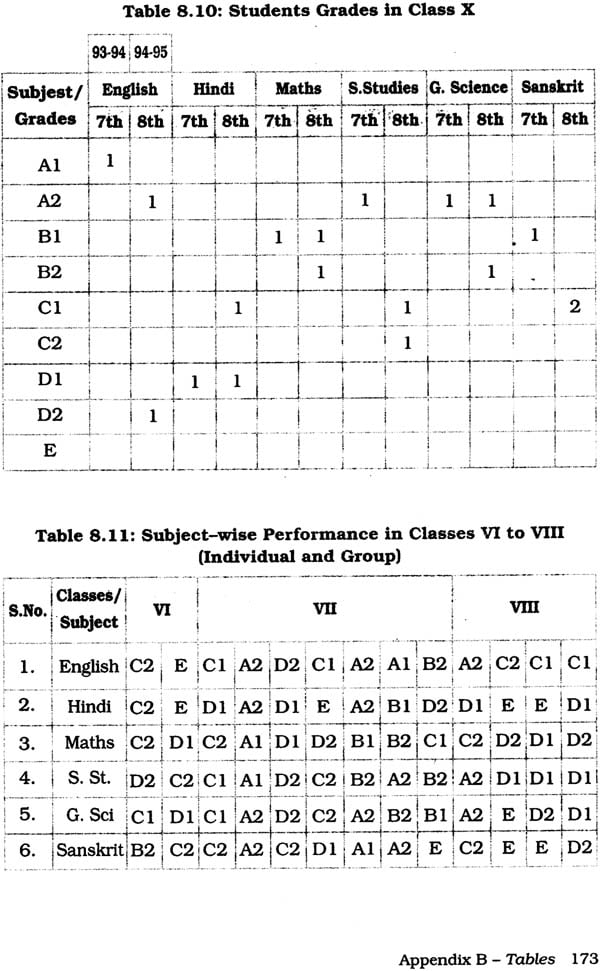
Life at Mirambika (A Free Progress School)
Book Specification
| Item Code: | NAN659 |
| Author: | Anjum Sibia |
| Publisher: | National Council of Educational Research and Training |
| Language: | English |
| Edition: | 2008 |
| ISBN: | 8174506284 |
| Pages: | 188 |
| Cover: | Paperback |
| Other Details | 9.5 inch X 6.5 inch |
| Weight | 300 gm |
Book Description
All schools aim at providing education. Though, they may differ in various aspects: their stated objectives; their definition of schooling; goals set for children; teaching approach adopted; the total atmosphere for teaching-learning interactions; the relationship between the teacher and the taught; the manner in which the school day is organised; and the mode of assessment. These variations are indeed the outcome of the differing ideologies practiced by schools. In this context, insights of innovations carried out in schools can be obtained by examining the initiatives undertaken by them in seeking alternatives in curriculum, teaching and learning, measuring success, involving children in the process of learning and approaches to learning from one another. Sri Aurobindo's educational thought lays emphasis on holistic development of the children and education paced according to the needs and capacities of the child. The implied role of the teacher in this process is that of a facilitator. Mirambika - A Free Progress School seeks innovations/alternatives in curriculum with respect to both content as well as transaction by putting into practice the educational thoughts of Sri Aurobindo and the Mother.
This book based on the research study attempts to explicate the pedagogic processes taking place in the classroom at Mirambika with the view to examine the probable influence of school philosophy on school organisation, teaching-learning process and student outcomes. This in turn reveals the school culture and ethos. The book provides the reader a simple functional view of the school processes with the aim to help build an understanding of the schooling at Mirambika. A case study approach to study Mirambika helped to evolve an understanding of the school through detailed observation of its people and their activities. An understanding of the school was built mainly through personal observations, informal interactions and by examining the perceptions of the participants namely, the teachers, the students and the parents. It is sought to provide an interpretation of the various school processes by giving a 'feel' of what they mean to the participants. While highlighting the significant issues an attempt has been made to reconstruct the ambience of the school and to examine the influence of ideology on it.
The book is organised to provide a brief overview of education in India (Section I), along with the views of Indian Philosophers on education. More specifically, the salient features of Sri Aurobindo's educational thought and principles of teaching are presented, as they form the base and provide guidelines for the functioning of Mirambika. Section 11 introduces the school - Mirambika, by giving the background of the school, its physical organisation and resources. Section III on organisational structure, focuses on the roles and responsibilities of the participants and decision-making in school. How teaching learning is organised in school is dealt with in Section N. It examines the strategies evolved, activities carried out, nature and type of evaluation and the interactions observed between the teacher and the students that shape the learning taking place in the classroom. The 'school culture' is the net total of the norms and values underlying the various activities (i.e. routine and formal) carried out in school. Section V on school culture provides a comprehensive view of the various activities undertaken in Mirambika and the meaning that these activities have for its participants. The teachers (or the 'Diuas' as they are referred to in Mirambika) are the main focus of Section VI. An attempt is made to present a comprehensive profile of the teacher, their expectations, aspirations and roles along with their understanding of the various activities in school. The parents and their recollections of Mirambika, expectations from the school and their own children form part of Section VII. A follow-up of students who joined the Mother's International School after completion of their studies in Mirambika is the main concern of Section VIII. It deals with two aspects, the personal-social characteristics of the Mirambika child and the academic achievement of these students in different subject areas across Classes VI to XII. The perceptions of the parents, teachers and children are weaved in, in order to provide a profile of the Mirambika child. Lastly, reflecting on the role of ideology in shaping the work undertaken in school, a few thoughts on some lines of enquiry emerging from the present research are presented in Section IX. Appendix A provides an account of experiences in the field delineating the processes of data collection along with methods of enquiry. It provides an idea to the readers about entry to the research site, data collection and exit.
The innovative teaching and learning approach followed in Mirambika provides an alternative perspective to schooling. I do hope that this will stimulate educators to think laterally and initiate a change in the present classroom teaching environment/ ethos which is highly structured, time-wise rigid and examination oriented.
Contents
| Preface | iii | |
| 1 | Introduction | 1 |
| 2 | Mirambika- The School | 11 |
| 3 | Organisational Structure | 32 |
| 4 | Teaching- Learning Apporoach | 46 |
| 5 | School Culture- Rituals and Celebrations | 75 |
| 6 | Mirambika Teachers- The 'Diyas' | 97 |
| 7 | Parents-profiles and Perspectives | 111 |
| 8 | The Mirambika Child | 123 |
| 9 | Concluding Comments | 149 |
| Appendix A- Fieldwork Experiences | 157 | |
| Appendix B- Tables | 169 | |
| Selected Bibliography | 174 |
Sample Pages













